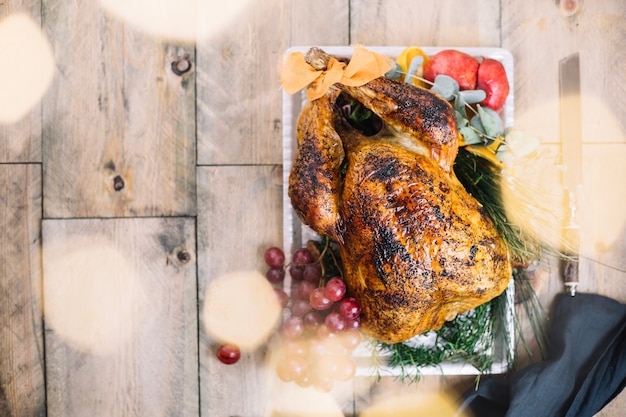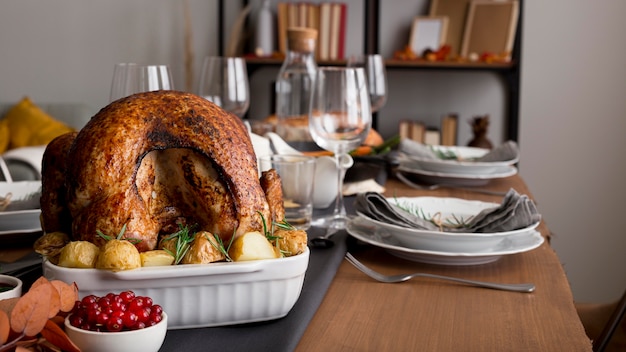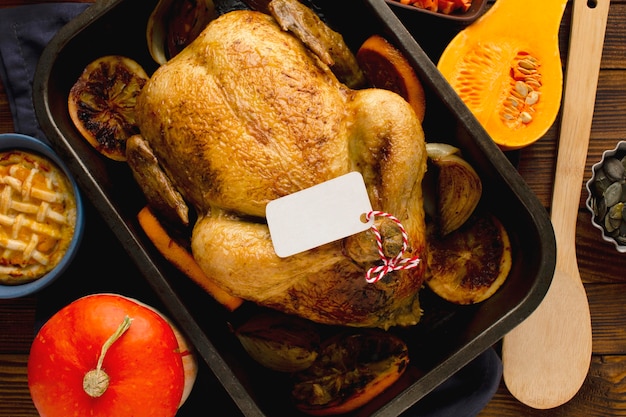Thanksgiving. The mere mention of the word conjures up images of warm, inviting homes filled with the aroma of cinnamon and cloves, families gathered around a table laden with delectable dishes, and the centerpiece of it all – the majestic turkey. But getting that bird just right, with a golden-brown, crispy skin and succulent meat, takes a bit of culinary know-how.
The fear of dry, flavourless turkey is a common one, making many Thanksgiving cooks tremble at the thought of roasting the centerpiece. But fear not, my fellow food enthusiasts! I'm here to guide you through the art and science of turkey cooking temperature, ensuring a thanksgiving feast that will have your guests singing your praises.
Part 1: The Foundations of perfect turkey

The Importance of internal temperature
Before we dive into the specifics of turkey cooking temperature, let's understand why it's such a critical element. You see, roasting a turkey is all about achieving a beautiful balance – a crispy, flavorful skin and perfectly cooked meat throughout, without any dryness. The key to success lies in mastering the internal temperature of the bird.
Imagine your turkey as a complex puzzle. Each piece – the breast, thighs, drumsticks – needs to be cooked to the perfect temperature to create a harmonious whole. Undercook the breast, and you risk a raw center, rendering the entire dish unsafe. Overcook it, and the meat will become dry and rubbery, a culinary tragedy in the making.
Understanding the Science of Cooking
Now, let's delve a bit deeper into the science behind turkey cooking. The temperature you use directly affects how the proteins within the meat behave. Think of proteins as tiny little bundles of energy. When you apply heat, these bundles begin to unravel and rearrange themselves. This is the process that makes meat firm up and become cooked.
The key is to find the ideal temperature range where the proteins have rearranged enough for the meat to be safe to eat, without overdoing it and resulting in dryness. This is why using a meat thermometer is crucial; it allows you to monitor the internal temperature of your turkey and ensure it reaches the desired point, leading to a juicy and flavorful masterpiece.
Part 2: The Golden Rules of Turkey Cooking Temperature

Target Temperatures: The Key to Success
Let's get down to the brass tacks of turkey cooking temperature targets. The USDA recommends a minimum internal temperature of 165°F (74°C) for the thickest part of the thigh to guarantee safety. However, for a truly delicious and juicy turkey, aiming for a slightly higher temperature of 170°F (77°C) is ideal. Don't worry about overshooting the mark slightly, as the turkey will continue to cook even after you remove it from the oven.
The key is to cook your turkey slowly and evenly until it reaches the desired internal temperature. A slow roast is the key to a succulent, flavorful turkey. Remember, the turkey will continue to cook even after you remove it from the oven.
Turkey cooking time: A Guide for Every Size
Now, the cooking time will depend on the size of your turkey. A general rule of thumb is to allow about 15 minutes per pound for a stuffed turkey and 13 minutes per pound for an unstuffed turkey. However, always rely on a meat thermometer for accurate results.
Never rush the cooking process. A slow and steady roast is the key to a succulent, flavorful turkey. A turkey will continue to cook even after you remove it from the oven, so don't worry about overshooting the mark slightly.
The Importance of Rest: Giving the Turkey Time to Rejuvenate
Once your turkey reaches the target temperature, it's tempting to carve it right away. However, resist that urge! Allow the turkey to rest for 30 minutes before carving. This crucial step allows the juices to redistribute throughout the meat, resulting in a much juicier and more flavorful final product.
Using a Meat Thermometer: Your Culinary Compass
Let's face it, a meat thermometer is your indispensable tool when cooking a turkey. It eliminates any guesswork and ensures that your turkey is cooked perfectly. Here's the trick: insert the thermometer into the thickest part of the thigh, making sure to avoid bone. The bone will give you a false reading.
The best way to know if your turkey is cooked through is to insert your thermometer into the thickest part of the thigh. Avoid hitting the bone, as this will give you a false reading.
Part 3: The Art of Roasting: From Preparation to Presentation

Oven Temperatures and Techniques: Setting the Stage
Let's talk oven temperatures! For a turkey, the ideal temperature is around 325°F (163°C). But before you pop that beautiful bird in the oven, there's a simple yet powerful technique you can employ: the dry brine.
Dry Brining: A Simple Yet Effective Method
Dry brining is akin to giving your turkey a spa treatment before its oven journey. Simply rub a mixture of salt and spices all over the turkey and let it sit uncovered in the refrigerator for 12-24 hours. The salt draws out moisture from the turkey, creating a tender and juicy meat, while the spices infuse it with delicious flavor.
Don't worry if you're short on time! You can still achieve great results with a shorter brining period, even 4-6 hours will make a noticeable difference. The longer you brine, the more flavorful and tender your turkey will be.
The Importance of Tying the Turkey: Ensuring Even Cooking
Before placing your turkey in the oven, take a moment to tie it up. This simple step helps ensure even cooking and prevents the breast from drying out. There are several ways to tie a turkey, but the easiest is using kitchen twine. Simply criss-cross the twine around the turkey's legs and wings, securing it tightly.
For enhanced air circulation and a crispy skin, elevate the turkey on a roasting rack.
Flavoring Your Turkey: Unleash Your Culinary Creativity
Now, let's talk flavor! Don't limit yourself to just salt and pepper. Get creative and experiment with your favorite herbs and spices. Rosemary, thyme, garlic, sage, and onion powder are classic choices. You can even create your own custom spice blend to make your turkey truly unique.
For an extra flavor boost, rub your turkey with butter or olive oil before roasting. This helps to create a beautiful golden-brown crust and enhances the flavor of the meat.
The Role of Basting: Keeping the Turkey Moist and Flavorful
Basting your turkey throughout the cooking process is a fantastic way to keep it moist and flavorful. Simply spoon the juices from the bottom of the roasting pan over the turkey every 30-45 minutes. You can also use a basting brush for even distribution of the juices.
For an added flavor dimension, include a few vegetables like onions, carrots, and celery in the roasting pan. They will release their flavors into the juices, creating a delicious sauce to baste your turkey with.
Part 4: Troubleshooting Common Turkey Cooking Problems
Dry Breast, Juicy Legs: Unveiling the Mystery and Finding Solutions
Ah, the age-old dilemma: a dry turkey breast and juicy legs. It's a common problem, but there's a simple solution: cook the turkey at a lower temperature for a longer duration. This ensures that the breast cooks evenly without drying out while the thighs reach the proper temperature. This is where a meat thermometer comes in handy to guide you through the process.
Overcooked Turkey: Recovering from a Culinary Mishap
Overcooked turkey can be a culinary disaster, but don't despair! There are a few tricks to salvage the situation. First, try shredding the meat and adding it to a casserole or soup. This is a great way to use up leftover turkey and create a delicious meal.
Another option is to carve the turkey and serve it with a flavorful sauce. A creamy gravy or cranberry sauce can help to mask the dryness.
Undercooked Turkey: The Importance of Patience
An undercooked turkey is a safety concern, so it's crucial to ensure it's cooked thoroughly. If you're unsure if your turkey is cooked through, use a meat thermometer to check the temperature in the thickest part of the thigh. If it's not yet at 165°F (74°C), continue cooking until it reaches that temperature.
Remember, patience is key when cooking a turkey. Don't rush the process!
Part 5: Leftover Turkey: Creative Recipes
From Roast to Sandwiches: Turning Leftovers into Culinary Delights
The turkey has been roasted, the feast has been devoured, and now you're left with a mountain of leftover turkey. But before you sigh and think about all the turkey sandwiches in your future, remember: leftovers are an opportunity for culinary creativity!
turkey pot pie: A Comforting Classic
Who doesn't love a comforting pot pie? Transform leftover turkey, vegetables, and a flaky crust into a delicious turkey pot pie. It's a great way to use up leftover turkey and vegetables, and it's always a hit with the whole family.
Turkey Shepherd's Pie: A Hearty and Satisfying Meal
Shepherd's pie is a classic comfort food, and it's even better with leftover turkey! Simply layer mashed potatoes over a mixture of leftover turkey, vegetables, and gravy. It's a hearty and satisfying meal that everyone will love.
turkey soup: A Warm and Nourishing Treat
Turn leftover turkey into a delicious and nourishing soup. Add leftover turkey to a base of broth and vegetables, and you've got a meal that's both comforting and satisfying.
turkey salad Sandwiches: A Quick and Easy Lunch
Of course, you can always whip up some delicious turkey salad sandwiches. Simply combine leftover turkey with mayonnaise, celery, onion, and your favourite spices. It's a quick and easy lunch option that's perfect for busy days.
Part 6: Beyond the Basics: Mastering the Turkey Roast
The Art of Stuffing: A Delicious Addition to Your Feast
Let's talk about stuffing! Stuffing can be a delicious addition to your Thanksgiving feast, but it's important to cook it safely. Here are a few key tips:
First, choose a safe recipe. The stuffing should be cooked to an internal temperature of 165°F (74°C). You can bake the stuffing separately or cook it inside the turkey. If you're cooking it inside the turkey, make sure the stuffing is loose enough to allow heat to circulate evenly.
If you're stuffing the turkey, make sure it's cooked thoroughly. The USDA recommends cooking the stuffing separately to ensure it reaches a safe internal temperature.
Different Turkey Styles: Exploring Unique roasting techniques
Now, let's explore different turkey roasting styles. If you're feeling adventurous, try roasting your turkey upside down. This method helps to create a juicier breast.
Another option is to spatchcock your turkey. This involves flattening the bird by removing the backbone. This method allows for faster cooking and a crispier skin.
The Importance of Patience: The Key to Culinary Success
Cooking a turkey takes time and patience. Don't rush the process. Remember, the key to a delicious and juicy turkey is to cook it slowly and evenly.
When in doubt, always err on the side of caution. Use a meat thermometer to ensure your turkey is cooked to a safe internal temperature.
Part 7: Festive Turkey Presentation: Making Your Creation Shine
The Finishing Touches: Elevating Your Culinary Creation
You've cooked your turkey to perfection, but now it's time to make it truly shine! Presentation matters, especially for a special occasion like Thanksgiving.
Carving Techniques: A Guide to Mastering the Art
carving a turkey can seem daunting, but it's actually quite simple. First, remove the legs and thighs by cutting through the joints. Then, carve the breast meat by slicing against the grain.
Garnishing for Style: Adding a Touch of Elegance
To elevate your turkey presentation, consider garnishing it with fresh herbs, cranberries, or citrus slices. These simple touches add a touch of elegance and colour to your festive table.
Arranging the Feast: Creating a Visually Appealing Spread
When arranging your Thanksgiving feast, consider placing the turkey in the centre of the table as the star of the show. Surround it with side dishes and sauces, creating a visually appealing and delicious spread.
Part 8: FAQs: Answering Your Most Frequently Asked Questions
1. Can I cook a turkey in a slow cooker?
While it's possible to cook turkey parts like breasts or thighs in a slow cooker, it's not recommended to cook a whole turkey in a slow cooker. The size of most slow cookers is too small for a whole turkey, and the turkey may not cook evenly.
2. How long can I keep leftover turkey in the refrigerator?
You can safely store leftover turkey in the refrigerator for 3-4 days. Make sure to wrap the turkey tightly in plastic wrap or aluminum foil to prevent it from drying out.
3. What's the best way to reheat leftover turkey?
The oven is the best option for reheating a whole turkey, while the microwave is quicker for smaller portions. When reheating turkey on the stovetop, be sure to cook it over low heat and stir frequently to prevent it from drying out.
4. How do I keep my turkey from drying out?
The key is to cook it slowly and evenly, using a meat thermometer to ensure it's cooked to a safe internal temperature without overcooking. Basting the turkey with the juices from the roasting pan throughout the cooking process can also help retain moisture.
5. What are some tips for carving a turkey?
When carving a turkey, it's important to cut against the grain of the meat to prevent it from tearing. Use a sharp carving knife and work slowly and carefully. You can also use a carving fork to hold the turkey in place while carving.
Everyone is watching

Corn on the Cob: The Ultimate Guide to Perfectly Cooked Ears
Healthy MealsAh, corn on the cob. Just the name evokes images of sunny days, barbecues, and that sweet, juicy flavour that ...

Scallops: The Ultimate Guide to Perfect Cooking
Healthy MealsAh, scallops. Those delicate, sweet, and utterly delicious morsels of the sea. They hold a special place in my...

Spaghetti Squash: The Ultimate Guide to Cooking and Serving
Healthy MealsRemember that time you saw spaghetti squash at the supermarket, looking all bumpy and strange, and thought, "W...

Salmon Cooking Times: Perfect Guide for Every Recipe
Healthy MealsLet me tell you, cooking salmon is an art form. It's all about getting that perfect balance: juicy and tender,...

Ham Cooking Time: How Long to Bake, Smoke, or Boil a Delicious Ham
Healthy MealsAh, ham. It's a classic, isn't it? A real crowd-pleaser, especially around holidays. And when done right, it'...
